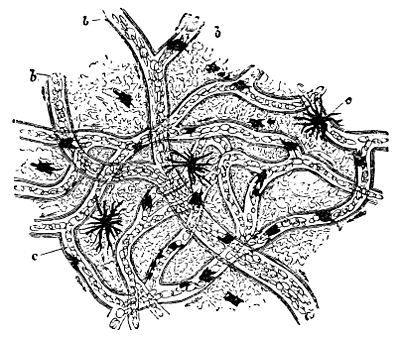exercise hastens the circulation. The movement of the chest in breathing probably aids the pulmonary circulation, the blood, as well as the atmosphere, tending to fill the vacuum during inspiration.
Physical capillary force is not generally regarded as an active force in the circulation. But there is an admitted force in the capillaries, resulting from the attraction of the tissues for the arterial blood, containing the required oxygen and nutriment. "The vital condition of the tissue becomes a factor in the maintenance of the circulation." It is this force, primarily, which adapts the amount of blood to the varying needs of any organ; the nervous system regulates the supply by varying the caliber of the vessels.
The force in the capillaries, or some other force, carries the blood, after death, from the arteries, where the heart leaves it, into the veins.

Finding the arteries empty after death gave rise to the idea that they conveyed only air; whence the name. It was this belief which Harvey overthrew in 1620.
In bats the heart is aided by the rhythmic contraction of the veins in the wing. Other accessory hearts of the lower animals have already been mentioned. In some of the lowest creatures, the cause of the circulation may be wholly the movements of the body, as in the jelly-fish and anemone; or by cilia, as in the sponge, where the sea-water answers to blood.
Under the influence of nerve-force, the walls of the arteries and capillaries are usually somewhat contracted. The withdrawal of nerve stimulus allows the tubes to relax, which consequently permits more blood to pass through, or to accumulate, and perhaps add color to

